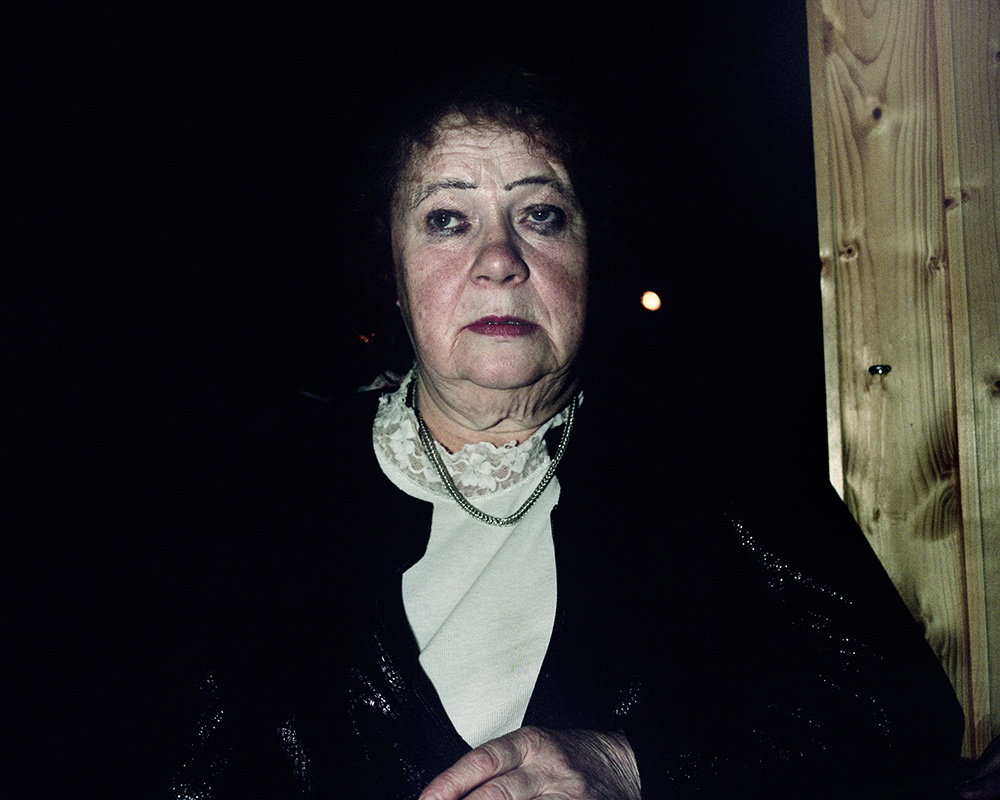In 1835, the Finnish linguist Elias Lönnrot published the Kalevala, a compilation of traditional epic poetry. In his home country, the Kalevala is now considered to be one of the most important works of literature of all time. I guess you could say that the Kalevala is to Finland what the Iliad is to the rest of the world.Five photographers traveled to Kainuu in Northeast Finland, the birthplace of the Kalevala, and explored the mythology through contemporary photography. I called up one of the guys, Aapo, to chat about the project.
Advertisement
VICE: Hey, Aapo. Tell me why you got interested in the Kalevala.
Aapo Huhta: You know Greek mythology, right? The Kalevala is like the Finnish version. It's a collection of stories from a long time ago. They're like folklore stories, about the beginning of the world and major things like that. Since one man collected the stories in the Kainuu area, our project is based around that. These days, things are changing between cities and the countryside. In Helsinki we have a routine kind of life but in the countryside life is, in a way, going backwards. So we wanted to explore that while having these old stories about Finland in mind. But it's not really documentary-based work. Part of it is about the group experience of Kainuu but at the same time everyone had the freedom to explore the place in their own way.
Aapo Huhta: You know Greek mythology, right? The Kalevala is like the Finnish version. It's a collection of stories from a long time ago. They're like folklore stories, about the beginning of the world and major things like that. Since one man collected the stories in the Kainuu area, our project is based around that. These days, things are changing between cities and the countryside. In Helsinki we have a routine kind of life but in the countryside life is, in a way, going backwards. So we wanted to explore that while having these old stories about Finland in mind. But it's not really documentary-based work. Part of it is about the group experience of Kainuu but at the same time everyone had the freedom to explore the place in their own way.

Photo by Maria Gallen-KallelaIs this mythology something that Finnish kids get taught about in school?
Yes, everybody touches upon these stories at school. But generally, people aren't very familiar with them any more. I mean, I knew about them from school and now I've learned more about them through this project.What's happening in the Kainuu region at the moment?
I think the same thing is happening in Finland as in Sweden, that people are moving away from the countryside. There aren't that many young people living there any more. Old people are staying there but there aren't many social services left, unfortunately.
Yes, everybody touches upon these stories at school. But generally, people aren't very familiar with them any more. I mean, I knew about them from school and now I've learned more about them through this project.What's happening in the Kainuu region at the moment?
I think the same thing is happening in Finland as in Sweden, that people are moving away from the countryside. There aren't that many young people living there any more. Old people are staying there but there aren't many social services left, unfortunately.
Advertisement

Photo by Helen KorpakThere are quite a lot of young people in your photo series, though.
Yeah, there are some. Helen is the one who's been exploring young people the most. Then again, young people living in Helsinki have totally different perspectives on the world to people living up in the North. For instance, to them, international culture is seen as really different. Helen did a few close-ups of things related to LA, rap and pop music—stuff that is really far from Kainuu but that's still happening in the region.There's a guy in one of Helen's photos who's dressed in all Southern American clothes. Is that a type of thing that's common in Kainuu?
I think it's more that people in this area have a similar way of life. I guess I have to ask Helen about that specific photo, but I'd say that it's a reference to the countryside, a reference to the symbolism from the US.
Yeah, there are some. Helen is the one who's been exploring young people the most. Then again, young people living in Helsinki have totally different perspectives on the world to people living up in the North. For instance, to them, international culture is seen as really different. Helen did a few close-ups of things related to LA, rap and pop music—stuff that is really far from Kainuu but that's still happening in the region.There's a guy in one of Helen's photos who's dressed in all Southern American clothes. Is that a type of thing that's common in Kainuu?
I think it's more that people in this area have a similar way of life. I guess I have to ask Helen about that specific photo, but I'd say that it's a reference to the countryside, a reference to the symbolism from the US.

Photo by Aapo HuhtaWho's the man in the bathtub?
I asked around about different characters that everybody in these villages knew about. I heard about all these lonely, old men living in wooden houses without access to social services. I found myself knocking on the door at this man's place. He didn't open so I went to the neighbor's who gave me his phone number. I called him and he showed me around his whole place. He had built a sauna and this bath thing in a garage, so I asked if I could photograph him. To me, that was really Finnish. Maybe because of the sauna, but probably because he was so alone there as well.
I asked around about different characters that everybody in these villages knew about. I heard about all these lonely, old men living in wooden houses without access to social services. I found myself knocking on the door at this man's place. He didn't open so I went to the neighbor's who gave me his phone number. I called him and he showed me around his whole place. He had built a sauna and this bath thing in a garage, so I asked if I could photograph him. To me, that was really Finnish. Maybe because of the sauna, but probably because he was so alone there as well.
Advertisement
Did you get any ideas of how these people you photographed view their lives? I'm thinking about the photo of the lady in the bed.
Generally, all the people I met were really happy to have visitors. It doesn't really happen to them that strangers come to these places and ask about their lives so they were all really friendly. That lady was actually a wife of the man in the bathtub. I drank so many coffees with them! I think they know that their lives are looked upon as rough. Social media and things like that aren't something they're used to or know anything about. One guy I met was cutting wood for a fire in the kitchen and just had a completely different lifestyle from what I'm used to.What are your conclusions around the mythology? What remains of the past?
I think you can see this really Scandinavian or Finnish way of living in some of the photos. Have you ever heard about the Talvivaara mine?
Generally, all the people I met were really happy to have visitors. It doesn't really happen to them that strangers come to these places and ask about their lives so they were all really friendly. That lady was actually a wife of the man in the bathtub. I drank so many coffees with them! I think they know that their lives are looked upon as rough. Social media and things like that aren't something they're used to or know anything about. One guy I met was cutting wood for a fire in the kitchen and just had a completely different lifestyle from what I'm used to.What are your conclusions around the mythology? What remains of the past?
I think you can see this really Scandinavian or Finnish way of living in some of the photos. Have you ever heard about the Talvivaara mine?

Photo by Juuso WesterlundYes, I have actually. But please explain.
In the folklore stories, there's this thing called Sampo, which is like a tool or machine that produces all the goods for the locals. People in the story go mad about it because everybody wants it, so in the end the locals destroy it. One of the photographers, Juuso, decided to shoot the Talvivaara mine for a contemporary angle on this story. The mine has loads of environmental issues around it, so it's like it's destroying itself. That's a good example of what we were trying to do, to look at it all from a contemporary perspective. Talvivaara is like Sampo, in a way.
In the folklore stories, there's this thing called Sampo, which is like a tool or machine that produces all the goods for the locals. People in the story go mad about it because everybody wants it, so in the end the locals destroy it. One of the photographers, Juuso, decided to shoot the Talvivaara mine for a contemporary angle on this story. The mine has loads of environmental issues around it, so it's like it's destroying itself. That's a good example of what we were trying to do, to look at it all from a contemporary perspective. Talvivaara is like Sampo, in a way.
Advertisement
I've been following the Talvivaara disaster for a long time. Is it located in this region?
Yes. We wanted to avoid a journalistic approach to that, such as taking photos of dead birds by the lake close to Talvivaara. So what Juuso did was take beautiful, dramatic photos of the area around Talvivaara in the winter.Our project is about playing with these old traditions and adapting them into today. I'm really happy about Juuso's approach because it allowed us to talk about the issue without underlining or simplifying the topic too much. Also, Helen shot a photo of a 15-year-old girl called Petra. And in the Kalevala story there's a main character called Aino, who's a young Finnish woman who the old men are trying to get at. So it's all about playing with these traditional stories in contemporary Finland.I see. Thanks, Aapo!See more photos here.Follow Caisa Ederyd on Twitter.
Yes. We wanted to avoid a journalistic approach to that, such as taking photos of dead birds by the lake close to Talvivaara. So what Juuso did was take beautiful, dramatic photos of the area around Talvivaara in the winter.Our project is about playing with these old traditions and adapting them into today. I'm really happy about Juuso's approach because it allowed us to talk about the issue without underlining or simplifying the topic too much. Also, Helen shot a photo of a 15-year-old girl called Petra. And in the Kalevala story there's a main character called Aino, who's a young Finnish woman who the old men are trying to get at. So it's all about playing with these traditional stories in contemporary Finland.I see. Thanks, Aapo!See more photos here.Follow Caisa Ederyd on Twitter.
Juuso Westerlund
Sunrise at VimpelinlampiJussi Särkilahti
A Bubble HallMaria Gallen-Kallela
Aapo Huhta
Juuso Westerlund
Juuso Westerlund
Helen Korpak
A Sweating ManJussi Särkilahti
Jouni Maria Gallen-Kallela
Aapo huhta
Teenagers PosingJussi Särkilahti
GreyhoundJussi Särkilahti
Helen Korpak
Helen Korpak
Aapo Huhta
Juuso Westerlund
Boys In WaterJussi Särkilahti
Helen Korpak
On a School RoadMaria Gallen-Kallela
